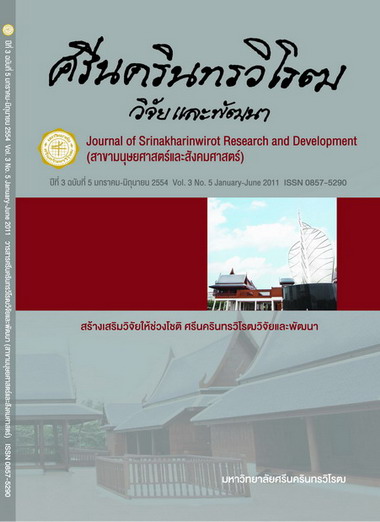การส่งเสริมการปรับเปลี่ยนพฤติกรรมการบริโภคของเด็กวัยเรียน (AN ENHANCEMENT OF A CHANGE IN CONSUMPTION BEHAVIOR OF SCHOOL-CHILDREN)
Keywords:
A change in behavior, Consumption, School-childrenAbstract
บทคัดย่อในปัจจุบันปัญหาโภชนาการของเด็กวัยเรียนมีเพิ่มมากขึ้น เนื่องจากมีหลายปัจจัยที่ส่งผลให้เด็กวัยเรียนมีพฤติกรรมการบริโภคที่ไม่เหมาะสม งานวิจัยนี้จึงได้ศึกษาถึงพฤติกรรมการบริโภคของเด็กวัยเรียนในการเลือกรับประทานอาหาร และสร้างแนวทางในการส่งเสริมการปรับเปลี่ยนพฤติกรรมของเด็กในวัยเรียน เพื่อให้เด็กวัยเรียนเลือกรับประทานอาหารที่เป็นประโยชน์ โดยจะศึกษาถึงพฤติกรรมการบริโภคของนักเรียนระดับประถมศึกษาชั้นปีที่ 4-6 และมัธยมศึกษาปีที่ 1-6 ในจังหวัดเชียงใหม่ จำนวน 1,192 คน จาก 4 โรงเรียน เครื่องมือวิจัยใช้แบบสัมภาษณ์เพื่อเก็บข้อมูลเชิงปริมาณและเชิงคุณภาพ ทำการวิเคราะห์ข้อมูลด้วยโปรแกรม SPSS ด้วยสถิติค่าเฉลี่ย ร้อยละ และค่าไคสแควส์ (Chi-Square test) และนำผลการวิเคราะห์ สังเคราะห์ข้อมูลมาใช้ในการปรับเปลี่ยนพฤติกรรมการบริโภคของเด็กวัยเรียน โดยใช้กลุ่มตัวอย่างจากนักเรียนชั้นประถมศึกษาปีที่ 5 และนักเรียนชั้นมัธยมศึกษาปีที่ 4 จำนวน 66 คน จาก 2 โรงเรียน เป็นต้นแบบในการศึกษาทดลอง ผลการวิจัยพบว่า นักเรียนส่วนใหญ่มีพฤติกรรมการบริโภคที่ไม่เหมาะสมหลายอย่างด้วยกัน ได้แก่ การรับประทานอาหารไม่ครบ 5 หมู่ การไม่รับประทานผัก ผลไม้ การรับประทานอาหารที่มีรสจัด อาหารสำเร็จรูป การรับประทานขนมที่ไม่มีประโยชน์ และเลือกดื่มเครื่องดื่มที่ไม่มีประโยชน์ เช่น น้ำอัดลม ชา กาแฟ โออิชิ โอเลี้ยง เป็นต้น
การทดสอบความสัมพันธ์พบว่า เด็กวัยเรียนทุกระดับชั้นมีพฤติกรรมการบริโภคอาหารลอกเลียนแบบกัน ที่ระดับนัยสำคัญทางสถิติ ที่ 0.05 รายได้ของครอบครัวมีความสัมพันธ์กับพฤติกรรมการบริโภคอาหารประเภทหมูไก่ ปลา หรือเนื้อ และการดื่มนม ที่ระดับนัยสำคัญทางสถิติ ที่ 0.05 และมีความสัมพันธ์กับการรับประทานอาหาร 5 หมู่ ที่ระดับนัยสำคัญทางสถิติ ที่ 0.10 การได้รับการอบรมเลี้ยงดูอย่างใกล้ชิดจากผู้ปกครองมีความสัมพันธ์กับพฤติกรรมการบริโภคอาหารครบ 5 หมู่ ที่ระดับนัยสำคัญทางสถิติ ที่ 0.10 เจตคติมีความสัมพันธ์กับพฤติกรรมการบริโภคอาหารประเภทผัก การบริโภคอาหารที่สะอาด อาหารครบ 5 หมู่ และการดื่มนม ที่ระดับนัยสำคัญทางสถิติ ที่ 0.001 เท่ากัน และมีความสัมพันธ์กับการบริโภคอาหารครบ 3 มื้อ ที่ระดับนัยสำคัญทางสถิติ ที่ 0.05 เด็กวัยเรียนมีพฤติกรรมการบริโภคอาหารหลังเข้าร่วมโครงการถูกสุขลักษณะกว่าก่อนเข้าร่วมโครงการ คือ ระดับประถมศึกษาปีที่ 4-6 มีพฤติกรรมการบริโภคหลังเข้าร่วมโครงการถูกสุขลักษณะกว่าในการรับประทานผักเพิ่มขึ้นร้อยละ 4.00 การรับประทานผลไม้เพิ่มขึ้นร้อยละ 2.19 การรับประทานอาหารครบ 5 หมู่เพิ่มขึ้นร้อยละ 2.19 การรับประทานอาหารสำเร็จรูปบรรจุถุงพลาสติกลดลงร้อยละ 0.81 การรับประทานอาหารที่มีรสจัดลดลงร้อยละ 0.78 และการรับประทานลูกอม ลูกกวาดลดลงร้อยละ 0.39 และระดับมัธยมศึกษาปีที่ 1–6 มีพฤติกรรมการบริโภคหลังเข้าร่วมโครงการถูกสุขลักษณะกว่าในการรับประทานอาหารสำเร็จรูปบรรจุถุงพลาสติก ลดลงร้อยละ 0.77 การรับประทานลูกอม ลูกกวาด ลดลงร้อยละ 2.26 การดื่มเครื่องดื่มประเภทชา กาแฟ โออิชิ โอเลี้ยง ลดลงร้อยละ 1.44 และดื่มน้ำอัดลม ลดลงร้อยละ 0.71
Abstract
Problem concerning child and adolescence nutrition are growing at present due to many factors that lead to improper eating habits among school-children. This research, thus, aimed to examine the consumption behavior in terms of food choices among school-children and then develop the guidelines to encourage their behavioral change proper and healthy diets for their age. The study covered 1,192 samples of 4th-12th grade school-children from four schools in Chiang Mai City. The research quantitative analysis was preformed upon the result of descriptive statistics and Chi-square Test .The results of this ex ante study were used as background for the design of a pilot project on generating changes in eating habits among school-children, 66 samples of two sample groups, 5th graders and 10th graders of two schools in Chiang Mai City. The ex-ante study found most school-children had many improper eating behavior such as negligence of balanced diets, refusal to eat vegetables and fruits, preference for spicy and ready-made foods, eating junk snacks, and drinking no-health-benefit beverage like soda pop, tea, coffee, Oishi drinks and iced black coffee.
Hypothesis testing using Chi-square test revealed the following results: The school-children in all grades have a demonstration effect in eating behavior with the level of significance 0.05. There exist the relationship between household income and a good eating behavior such as pork or chicken or fish or meat and milk drinking at the level of significance 0.05 and has a relationship with a balanced diet food at the level of significance 0.10, respectively. A good care from parents can be explained the eating behavior of balanced diet food at 0.10 level of significance. A good attitude in health has a relationship with eating behavior of vegetable, clean food, balanced diet food, and drinking milk at 0.001 level of significance and has a relationship with three meals eating a day at 0.05 level of significance. The test comparing the school-children before and after attending the program to change consumption behavior revealed that the 4th–6th grade school-children had changed their eating behavior after attended the program in term of greater consumption of vegetable by 4% and of fruits by 2.19%, better nutritional balance by 2.19%, cutting down on ready-made take-home food in plastic bags by 0.81%, cutting down spicy food by 0.78% and candy by 0.39. The 1st-6th grade school-children cutting down on ready-made take-home food in plastic bags by 0.77%, cutting down candy by 2.26%, less consumption of tea, coffee, Oishi drinks and iced black coffee by 1.44%, and frizzy soft drink by 0.71%.
Downloads
Downloads
Published
How to Cite
Issue
Section
License
Srinakharinwirot Research and Development Journal of Humanities and Social Sciences is licensed Under a Creative Commons Attribution-NonCommercial-NoDerivs 4.0 International (CC-BY-NC-ND 4.0) License, Unless Otherwise Stated. Please Read Journal Policies Page for More Information on Open Access, Copyright and Permissions.



